Central Cairo - and Modern Cairo, Egypt
The area across from Gezira Island above Shari Ramses is generally known as Bulaq, and during the Ottoman period was a busy port and warehousing district, but today is a residential district, though the El-Balah Wakala is here with its various dealers in military surplus and scrap iron. Below that is Downtown Cairo which is of more interest to us. South of Downtown is Garden City, across from Rhoda Island, and to the east of that, Mounira. We have also included both Roda and Gezira Islands in this section.
Downtown
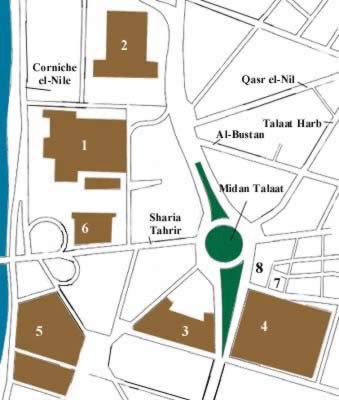
There is a good chance that most tourist and businessmen visiting Cairo will end up in central Cairo which is located on the east bank of the Nile. Standing on the 6th of October bridge, one may see both the Ramses and Nile Hiltons, the InterContinental (5) on the east side and the Cairo Sheraton and Cairo Marriott on the west, as well as many other smaller hotels.
Today, parts of this area are bustling with tourists, students, and Egyptians both at work and play because here one finds clusters of eating establishments including western fast foods, clubs and bars (particularly in the hotels), movies, banks and all manner of shops, along with the press district about half way between the Egyptian Museum and Ramses Station. This is not an old area of Cairo, or at least there are really no true antiquities to see. Though it is not the newest, most exclusive or finest hotel, we will begin our journey from the Nile Hilton (1), the first modern Hotel in Cairo. It is one of the author's favorite places to stay, and provides considerable entertainment within its dark wood bar and the constant weddings that traverse the lobby. There is a small mall attached with several good eating establishments, and a variety of clothing and other stores. Exit the back door and make a right for the mall. However, if you continue down the walk upon exiting the hotel grounds one finds considerable bus and tourist traffic, along with the hawkers of souvenirs. Just turn left and there you have it, the famous Egyptian Antiquities Museum (2) with, for example, Tut's treasures within a minutes walk. By the way, by all means buy some papyrus from the hawkers if you wish, but usually they can be haggled with for perhaps half the price they initially offer. The price gets better as the closing hours of the Museum approaches, and quantity discounts for the folks at home are also negotiable.
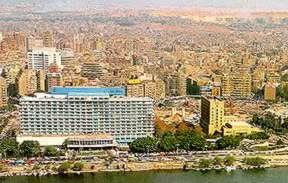
Upon leaving the museum and exiting its gates, take a left heading south to Sharia Tahrir (street). We will pass the Arab League Building (6) on the right. This is a major street, and along the way one may find many interesting shops. Turn left (east) on Sharia Tahrir and one finds themselves quickly at Midan Tahrir (Liberation Square), along with seemingly thousands of honking horns and chaotic traffic. While Midan Tahrir was once outside the city center, it now is a nucleus of activity. To the south of the square is the bureaucratic city of Mogamma (3) where 18,000 civil servants toil and almost every department of the Egyptian government has offices. Heading around the circle counter clock wise, the next complex to the south east will be the American University of Cairo (4), were the elite of Cairo attend University. Be aware that on the north side of AUC is Kentucky Fried Chicken (7) and McDonalds Hamburgers. No plug intended, other than after a few days this might be a quick fix for home sickness (I prefer KFC, as beef just doesn't seem to be favored in Egypt). AUC also has a good bookstore where one may find books about Egypt that simply are not available in the US. Also, north of AUC, is the Baba Cafeteria (8), the old haunt of Egypt's most famous author, Naguib Mahfouz.

At this point Sharia Tahrir leaves the square to the east. Down the street is Midan Falaki, a square located in an area known as Bab al-Lug. There is a food market here, which will not interest most westerners much but on the north side of the square is Cafeterial Horreyya (10), where one may stop in for a Stella (a local brand of bear) and a chess game.
However, continuing the journey down Al Bustan street brings us the Midan al-Gomhuryya (Square of the Republic), and Abdeen Palance Museum (9), where artifacts, often gifts and awards of former Egyptian leaders, are on display.
Retrace our way up the Al Bustan street back west, passing the turn on Sharia Tahrir until we arrive at Talaat Harb street, we will make a right heading north east. We will pass the old Cafe Riche (11), which is now closed but was once an intellectual Haunt. This will bring us to Midan Talaat Harb which is Downtown. The statue is of Mr. Harb, who founded the Egyptian National Bank. Groppi's tearoom (12) is here, famous among Egyptians and worth a visit. Heading back up Talaat Harb street, we will pass the Cinema Mar Girgis (13) building, a great movie palace of the 1930s era. About a block east along Adly street is the Shar Hashamain Synagogue (14), where the Jewish faithful still come to pray.
Heading back to Talaat Harb street, we can continue our journey North (right) until coming to Midan Qrabi, where eating establishments are scattered about, and head east on Alfy street. This is Downtown Cairo's nightlife center with a number of bars and all night restaurants. The area around the Ezbekiyya Gardens was once a vast lake but was drained in 1837. The area was constructed in accordance with a rigidly enforced plan. This was all done under the instructions of the Khedive, who loved entertainment and there was originally a circus, theater and opera house in the southern gardens. In earlier times, this was the hotel district, with such well known establishments as the famous Shepheards, There were a number of consulates located here, and it was a favorite district for European visitors.

Atfy Street connects with Al-Gonhuriyya to the east. Here, we will turn right heading south again. Where Abdei Khalek Sarwat Street intersects at a parking tower that was once the Midan Opera (15), head east (left) and the street should arrive at Midan Ataba, where modern Egypt meets medieval Cairo. Just to the north is Ezbekiyya Gardens where on the southeast corner a puppet theater (16) may be found. On the southwest corner of Midan Ataba is the general post office with its Postal Museum (17) located on the 1st floor and well worth a short but surprisingly informative visit. Around Midan Ataba is a huge bazaar, and to the east, Sharia Muski (street) leads into the Khan el-Khalili.Of interest also is that on the northern side of the square are found many booksellers.
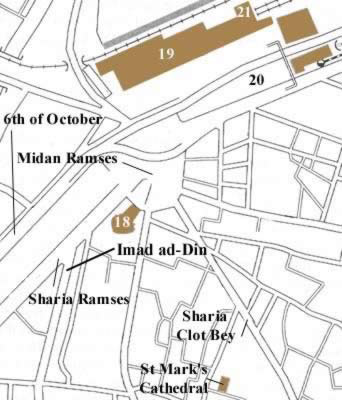
But let's not go there yet. Instead, we will head north from Midan Ataba on Sharia Clot Bey (Sharia Khulud), named for a French physician, Antoine Clot (Klute Bey) who was one of the founders of modern medicine in Egypt. Up ahead, the minaret belongs to the Al-Fath Mosque (18), which marks our current destination. This street passes under stone arches and lots of coffeehouses and restaurants before arriving at Midan Ramses in front of the Ramses station (19), which was first built in 1856, rebuilt in Arabic style in 1892 and refurbished in 1955. This is one of the oldest sections of new Cairo. The area is known as Bab el-Hadid (railway gate). Here, one is likely to encounter all manner of pedestrian and vehicular havoc. Here also is possibly a pharaonic statue of Ramses II (20), though it is suppose to be moved elsewhere. But the main attraction of the area is the Egyptian National Railways Museum (21) in the Ramses station's east end which has some fabulous old locomotives. It is also the departure preference for many people heading to Alexandria. Just south of the station off of Sharia Ramses is Imad ad-Din street, which was one of Cairo's first investment properties, and was once known as the Nightclub district.

Ramses Station
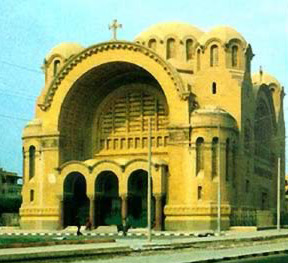
St. Mark's Catholic Church Near Ramses Station
Gezira Island
Gezira was mostly uninhabited and undeveloped into the mid 19th century. After the modern (central) city of Cairo was developed, Mohammed Ali built a palace and guard house at the northern tip. Apparently, there were problems with these buildings and the complex became known as As-Zamalik, which in Turkish translates to 'makeshift dwelling'. The northern section of the island is now called Zamalik. Later, the Khedive Ismail built a large palace in the center of the island with a huge garden, along with building up the sides of the island and a jetty to make access easier. At that time, the gardens contained exotic plant life and a collectionof African animals, fountains, pavilions and the Gezira Salamlik.
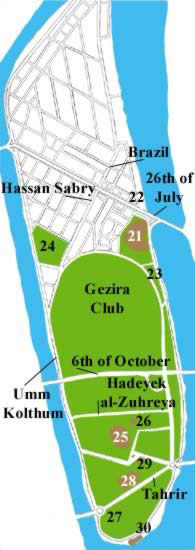
From Midan Ramses, head back southwest along 6th of October Street (Calaa) street. At the 26th of July street, head back west (right), though if one has an interest in bugs, go a little further and find the Entomological Museum located between the parallel streets of 6th of October and Sharia Ramses. 26th of July will cross the Nile onto Gezira Island past the Cairo Marriott (21). On the other side of the street is the Akhenaten Center of the Arts (22). Just behind the Marriott is the Gezira Center of Arts (and the Islamic Ceramics Museum) (23). From here, one may wonder into the upscale residential area of Zamalek to the north, were there are some fine restaurants. Just a little further west on 26th of July where Brazil street meets Hassan Sabry is the nerve center of the area with some fine shops and restaurants. Heading southwest on Hassan Sabry (left) one passes the Fish gardens (24) at about the location of the Gezira Club's northern boundary. The Gezira Sporting Club was established by the British in 1882, designed after London's Hurlingham Club, and continues to be very exclusive. Staying on Hassan Sabry we finally come to the eastern side of the island and Umm Kolthum (Gabaleyya) street along the Nile. In this southern region of the island there are few streets. Hadeyek al-Zuhreya leads past Ahly Stadium (25) and the Cairo Tower (26), where there is a restaurant on the upper floors. A little south of that road, leading off Umm Kolthum is Sharia Tahrir again which leads past first the Mahmound Mokhtar Museum (27), which is closed, the Cairo Opera House (28) (be sure to stop and get a current schedule) and finally reaches Midan Saad Zaghloul, a small square. Up the Northeast road from this square is the Museum of Modern Art (29). On the southern tip of the island is the Sheraton Gezira (30), which can be reached by returning to Umm Kolthum.
Rhoda Island and Garden City
From here, lets move back east across the Tahrir Bridge back to the east side of the Nile. Once across, turn left on the road that boarders to Nile. This is Corniche el-Nile, and one will soon arrive in Garden City. This area is worth a look around, as there are some fine old houses and a few upscale stores in the area. Many of the buildings here date from between 1925 and 1935, an era of Art Deco. However, continuing down the street we eventually come along side Rhoda Island.

During pharaonic times, Rhoda was part of ancient Heliopolis. Later, it had a fortress during Roman times complementing that of Babylon on the mainland. It was formed prior to Gezira, and the island's landmass has not changed much since the 7th century. Early on after the Islamic conquest, there were impressive buildings, towers and arsenals and an Arab fortress built here. At the southern end of the Island a Nilometer (32) was built and there is also the Manasterli Palace (33), but these are best visited from the area of old Cairo by river bus. The last Ayyubid sultan transferred the seat of government to the island and built a new fortress, palaces and a barracks around 1240, but the Mumluks returned the government to the Citadel. There was once many beautiful residences here, and the Manyal Gardens covered a considerable section of the island, but today, it is mostly a residential district. Most of what there is to see, is at the very northern and southern tips of the island.
Take the first bridge over and we will be in the area known as Manial. Heading down the road which borders the eastern edge of the Island we will come to the Manial Palace Complex (museum) (31), which houses a considerable collection of items from Prince Mohammed Ali Tawfig, the uncle of the last King of Egypt, Farouk. It is an interesting and much visited museum. There is also the old Meridien Hotel (34) on the north tip of the island, which can be reached by the eastern street leading along the Nile. Oh, and by the way, just down Sharia al-Saray to the east is another KFC! (With a little luck, if one asks, they might put enough ice in your coke to remind you of home).
Last Updated: June 11th, 2011
|